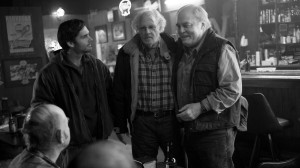The latest indignity seemingly imposed by commerce upon art is the news that the cable movie channel Epix would air, in addition to the original black-and-white version, a color version of Alexander Payne’s Nebraska, which was nominated for Best Picture earlier this year and stars Bruce Dern and Will Forte as a father and son on a somewhat discursive road trip nominally aimed at retrieving a cash payout to which the father believes he’s entitled.
This is not a colorized version ginned up after the fact; it’s existed all along as a contractual necessity facilitated by digital shooting, according to a Variety interview with Payne last fall, in which he openly hoped it would never be seen. There’s not necessarily anything wrong with the color version of the film — it’s not the optimal way to appreciate what the director and the rest of the creative team were going for, but “suboptimal” doesn’t mean “terrible.” It’s hard to imagine why anyone other than perhaps those with challenges seeing black and white images would want to watch a movie in what its creator considers an inferior form when the superior form is equally convenient. But if that were all this story suggested, that might not be such a big deal.
The real threat of this kind of thing, though, might be the way that digital presentations of content in general make it a lot easier to deliver things in lots and lots of different ways. It’s good to have flexibility, but it also means there might be a point where it becomes almost impossible to make your vision available to people without agreeing in advance to make it customizable to the point where it ceases to be art at all. You can imagine a future in which films are released from the outset in PG and R versions, or in black-and-white and color versions, or in longer and shorter versions, or in versions with two different scores.
There’s something to be said for choosing your own adventure, as it were, but there’s also something to be said for leaving the creative decisions to the creator of the piece, and accepting that that surrender of control is part of immersing yourself in somebody else’s work.
An analogy: If you order a steak and you want hot sauce on it, I am the last person to say you can’t have hot sauce, but I also believe it might be to your benefit not to demand hot sauce by default on every steak you ever eat. And I believe it is to your benefit — our benefit — that a restaurant focused on the creativity of chefs not announce on the menu, “Did you want hot sauce? Did you want an egg on top? Did you want a peanut butter sandwich instead?” It is one thing to grant special requests when you can; it is another to present the creative choice of a creative person as something to take or leave casually, according to what you think you already want.

9(MDAxOTAwOTE4MDEyMTkxMDAzNjczZDljZA004))

